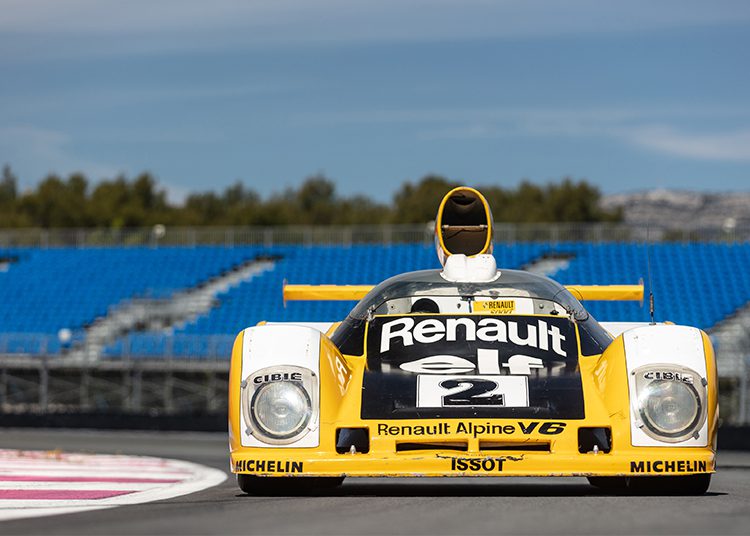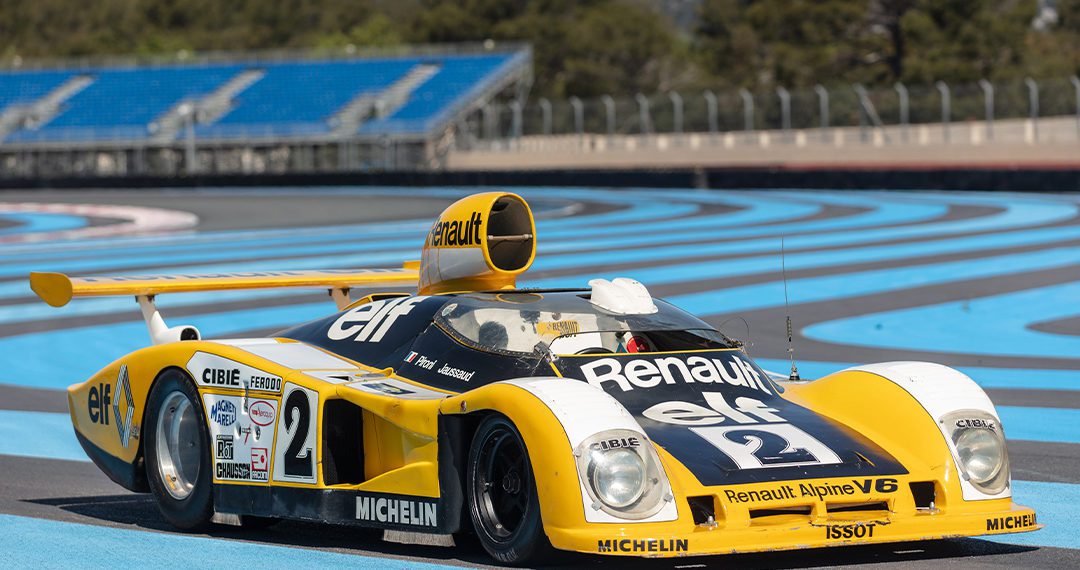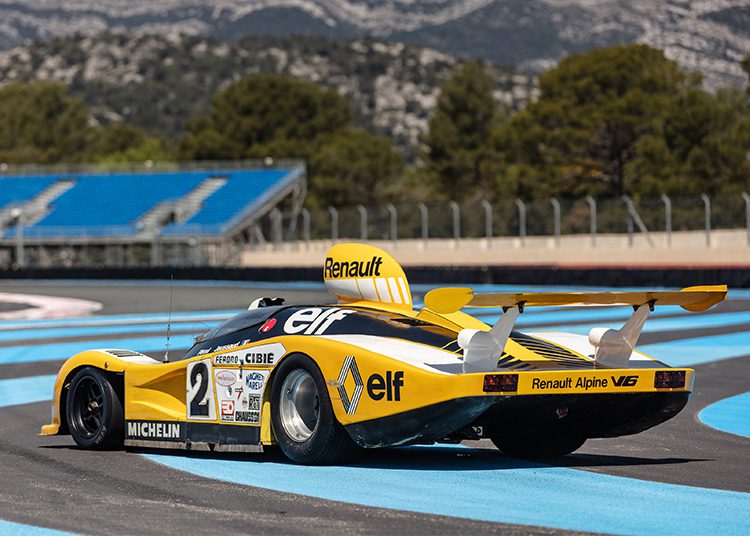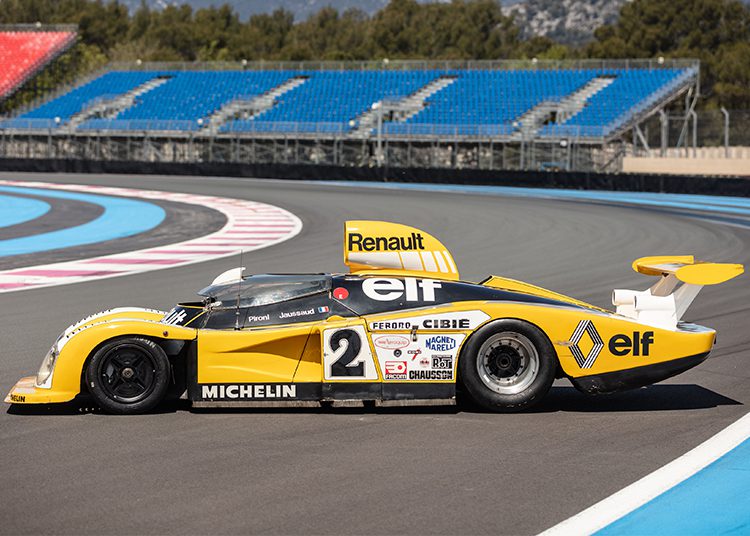Presented by RM Sotheby’s – Conceived as the successor to the Alpine A440 and A441—the prolific podium mainstays of European endurance racing in the 1970s—the A442 is one of the first to wear the Renault-Alpine badge following the merger between Renault, Alpine and the tuning firm, Gordini. The A442 was the first vehicle that the newly formed outfit would field on the racetrack and like its Alpine predecessors, the race car is powered by the Renault-Gordini V-6 2.0-liter engine. However, what would differentiate the A442 from previous models is the Garrett turbocharger that almost doubled its power output from 270 brake horsepower to a breath-taking 490 brake horsepower. Renault-Alpine built just four examples of the A442: chassis 4420, chassis 4421, chassis 4422, and 4423.
On 25 April 1976, this car, chassis number 4422, would make its first race appearance, driven by Henri Pescarolo and Jean-Pierre Jarier racing under number “1” at the 4 Hours of Monza, competing in the Trofeo Filippo Caracciolo. Chassis 4422 qualified 3rd and achieved an impressive 2nd place overall finish. The following month, chassis 4422 raced by Scheckter and Pescarolo under number “3” at the Imola 500 kilometers, a race where it would score a DNF. From 12 to 13 June, chassis 4422 is believed to have made its first appearance at Le Mans, used in practice sessions as car number “19”. On 27 June, chassis 4422 would race in the Coppa Florio under number “2” driven by Jacques Laffite and Patrick Depailler. The race was held at the Autódroma di Pergusa where the car achieved pole position in qualifying but unfortunately did not finish the race. Nearly two months later, chassis 4422 raced in the World Sports Car Championship at Mosport on August 22nd. Racing under number “1” and driven by Patrick Depailler the car qualified 4th and would eventually finish the race in the same position. On 5 September chassis 4442 was raced in the Dijon 500 Kilometers held at the Circuit des Dijon-Prenois. For this race the car was campaigned under number “4” and piloted by Jacques Laffite and Patrick Depailler. The car qualified 1st and would finish the race in 2nd place.
All four A442s were fielded by Renault-Alpine in the 1977 24 Hours of Le Mans. Chassis 4422, donned racing under number “8” and the Renault/Elf sponsorship livery. Team drivers for the race were Jacques Laffite and Patrick Depailler. Chassis 4422 would qualify second, behind only number “9” A442 driven by Jean-Pierre Jabouille and Derek Bell. Unfortunately, none of the A442s would finish the race, each retiring early due to engine problems. Chassis 4422 was the last to retire, completing 289 laps.
For the 1978 Le Mans, Renault-Sport would return, this time fielding two A442As, one A442B, and one A443. Determined to prove Renault’s ability to succeed at Le Mans, the race also served as a bid to prove the team’s mettle to Renault executives, who had sought to wind down Le Mans racing to focus solely on the Formula 1 team. Car number “3” was driven by Derek Bell and Jean-Pierre Jarier, it qualified 6th and would unfortunately DNF, completing 162 laps before retiring due to gearbox problems. Car number “1” was driven by Jean-Pierre Jabouille and Patrick Depailler, qualified 2nd and would nearly finish the race, completing 279 laps before retiring due to mechanical failure. Car number “4”, driven by Jean Ragnotti, Guy Frequelin, Jose Dolhem, and Jean-Pierre Jabouille, qualified 8th and would finish the race 4th having completed 359 laps. Car number “2”, the sole A442B, was piloted by Didier Pironi and Jean-Pierre Jaussaud. They would start the race in 5th and go on to secure Renault’s first overall victory at the famed 24-hour race. Their 370 completed laps were five more than the 2nd-place Martini Porsche 936 driven by Bob Wollek, Jurgen Barth, and Jacky Ickx. This historic result marked what would be the first and only Le Mans victory for Renault to date. With the renowned French marque winning the most prestigious race in motorsport, celebrations ensued across the country, highlighted by a parade in which the winning number “2” car was driven down the Champs-Élysées in Paris.
Following the 1978 Le Mans, chassis 4422 was owned by Jean Sage, who served as the director of the Renault Formula 1 team from 1977 to 1985. Mr. Sage, who would later become famous as a race manager for Ferrari’s F40 LM efforts as well as the race director/founder of the Ferrari Historic Challenge series, subsequently sold chassis 4422 to Adrien Maeght who would go onto display the car in his Musee de l’Automobiliste in Mougins, France for over 25 years. The car was then acquired from Mr. Maeght by Mr. Guikas in 2014, and it has been on static display in his collection ever since. Mechanically restored, we had the pleasure to see the car running on the Paul Ricard racetrack for the photo and video shooting.

Despite there being just two factory supported Renault cars in the 1978 Le Mans, the identity of the actual winning car has been in question for years. However, evidence on file compiled by Pierre Abeillon provides a compelling argument to it being this car. Over a period of 20 years Mr. Abeillon was able to compile evidence and inspect each Renault-Alpine A442 in person as a judge at the Goodwood Festival of Speed and various other events. Mr. Abeillon first noted that each A442 car exhibited unique features, as each car was hand-built. In particular, Abeillon took photographs of the rivets securing the chassis plate above the pedal boxes of each car and compared them to a period photograph of the winning Le Mans car with the body off and pedals exposed. What he discovered was that chassis 4423’s rivets do not match the rivets in the period photograph of the winning Le Mans car. The rivet pattern on chassis 4422, this car, has a rivet pattern that is identical to that of the Le Mans winning car. It should be noted that Renault disputes the fact that 4422 is the 1978 Le Mans winner, which they believe to be 4423; one of the main arguments being the presence on the A442 B and A443 of a bracket, welded to the chassis, that holds the bubble lock, and this bracket is not on 4422. RM Sotheby’s invites all interested parties to review the documentation on file for 4422.
As the only Renault-Alpine A442 in private hands, 4422 presents a unique opportunity for collectors to acquire one of the most successful sports racers of the late 1970s. Still in “time capsule” condition, 4422 remains virtually unaltered from 1978. Coming with a comprehensive spares package, including several spare engines and assorted other parts, 4422 could be prepared to make a glorious return to the track should the next caretaker wish to bring the car back to Circuit de la Sarthe in Le Mans or other historic racing venues.
RM Sotheby’s will present this vehicle as part of a single-owner collection comprised of 75 of the finest racing and road cars in the world, offered entirely without reserve. The Guikas Collection, to be sold at Paul Ricard Circuit in France in November 2021, presents pedigrees spanning from the endurance racing of the 24 Hours of the Le Mans to the world stage of Formula One and nearly everything in between. The collection of race cars will provide modern racing enthusiasts an introduction into virtually all vintage racing series worldwide, including GT and road cars that are equally impressive which offer a wide selection of Pre- and Post War sports cars.














